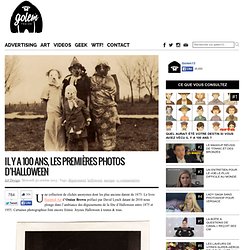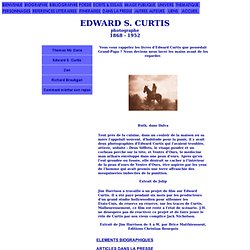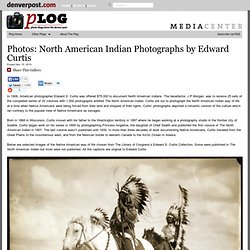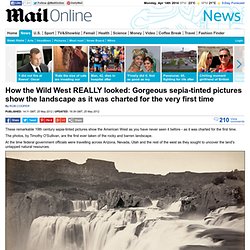

Il y a 100 ans, les premières photos d’Halloween. Une collection de clichés anonymes dont les plus anciens datent de 1875.

Le livre Haunted Air d’Ossian Brown préfacé par David Lynch datant de 2010 nous plonge dans l’ambiance des déguisements de la fête d’Halloween entre 1875 et 1955. Certaines photographies font encore frémir. Joyeux Halloween à toutes & tous. Anonymous Halloween photographs from c.1875–1955. Truly haunting Americana, with a foreword by David Lynch The photographs in Haunted Air provide an extraordinary glimpse into the traditions of this macabre festival from ages past, and form an important document of photographic history. Edward Curtis. D'après la biographie établie par Hans Christian Adam, photographe et auteur d'un livre sur E.S.

Curtis aux éditions Taschen Né en 1868 dans un ranch de l'Etat du Wisconsin, Edward Sheriff Curtis est le second des quatre enfants d'un prédicateur. Il acquiert très jeune sa première expérience de photographe puis apprend son métier dans un studio du Minnesota. Avec ses parents, Edward S. Curtis s'installe en 1887 à Sidney, dans l'Etat de Washington. C'est en 1895-1896 qu'Edward S. En 1899, Edward S. E.S. Extrait de l'article de Philippe Jacquin, LE FIGARO MAGAZINE du 23 septembre 2000 Exposition des photographies d'Edward S.
Il aura suffi d'un dollar. Extrait de l'article de Yasmine Youssi, EPOK, Octobre 2000 Ebloui par leur "danse du soleil", le photographe se jette à corps perdu dans une entreprise dont il ne soupçonne pas encore qu'elle sera celle de sa vie. Edward S. Curtis's The North American Indian (Enigma music) Edward Sherrif Curtis, Sur la piste rouge. Mais en montrant qu’il n’était pas lâche, en étant naturel, en devenant l’ami des enfants et en apprenant à vivre avec les Indiens Curtis obtint enfin leur respect .Un jour il déclara : « un Indien est comme un enfant, il sait instinctivement si on l’aime ou si on est condescendant avec lui.
Les Indiens savaient que je les aimais et que j’essayais de faire quelque chose pour eux ». Quelques années plus tard il dit à un journaliste du New York Times : « beaucoup d’Indiens non seulement sont prêts à aider mais ils en en ont envie, ils ont compris que mon travail serait un mémorial permanent pour leur race, le message passe entre les tribus et tous les chefs, même les plus réticents, veulent ma visite… »Ainsi, le chef Aigle Noir des Assiniboin qui était un vieillard de 90 ans n’avait jamais dit un mot au sujet de son peuple à un visage pâle. Photos d'indiens de Edward Curtis. Les Indiens sans les cow-boys. Curtis. Photographs of Native Americans by Edward Curtis. Posted Nov 15, 2010 Share This Gallery inShare88 In 1906, American photographer Edward S.

Curtis was offered $75,000 to document North American Indians. The benefactor, J.P Morgan, was to receive 25 sets of the completed series of 20 volumes with 1,500 photographs entitled The North American Indian. The American West as you've never seen it before: Amazing 19th century pictures show the landscape as it was chartered for the first time.
These remarkable 19th century sepia-tinted pictures show the American West as you have never seen it before - as it was charted for the first time.

The photos, by Timothy O'Sullivan, are the first ever taken of the rocky and barren landscape. At the time federal government officials were travelling across Arizona, Nevada, Utah and the rest of the west as they sought to uncover the land's untapped natural resources. Timothy O'Sullivan, who used a box camera, worked with the Government teams as they explored the land. He had earlier covered the U.S. Civil War and was one of the most famous photographers of the 19th century. He also took pictures of the Native American population for the first time as a team of artists, photographers, scientists and soldiers explored the land in the 1860s and 1870s. The images of the landscape were remarkable - because the majority of people at the time would not have known they were there or have ever had a chance to see it for themselves.
AMERINDIEN / AMERINDIENS / INDIENS D'AMERIQUE.